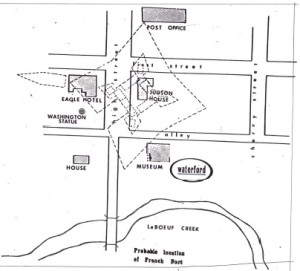The history of Waterford, PA begins with three forts from three different countries.
- French Fort 1753-1759, destroyed at that time
- British Fort-1760-1763 when burned down by Indians
- American Fort-1794 to open the area for settlement

The diagram shows where the original Fort LeBoeuf was located in regard to the current campus buildings.open the area to settlement.
The original Fort Le Boeuf, (often referred to as Fort de la Rivière au Bœuf), was established in 1753 by the French on LeBoeuf Creek, a fork of French Creek. It was part of a line that included Fort Presque Isle, Machault, and Duquesne. Located about 15 miles south of Lake Erie, it was used by the French to portage supplies and trade goods from Lake Erie down French Creek to the rivers Allegheny, Ohio, and Mississippi.
Construction began July 11, 1753, by Captain Paul Marin on 11 July 1753. Marin’s orders were to establish a fortified post on the south shore of Lake Erie, construct a road to the head-waters of the Allegheny River, make the Rivière au Bœuf (French Creek) navigable, then establish a chain of forts to the Ohio River, and garrison them. Marin, now 61 years old, drove himself and his 1,500 men unmercifully all through the summer and fall of 1753. He allowed nothing to stand in his way. Junior officers who showed a lack of zeal for the task were threatened with instant dismissal from the service. When the Iroquois protested the invasion of their lands they were bluntly told that if they opposed it they would be crushed. American fur-traders caught in the region were sent to Montreal in chains as a warning to others. Hundreds of the Canadian labor force sickened from poor food and overexertion; many perished and the wraith-like appearance of those who survived made Duquesne blanch when they arrived back at Montreal. Marin himself fell sick and refused to return to Montreal to convalesce. In September, Duquesne sent him the cross of Saint Louis, awarded in that year’s honors list. It arrived too late. Marin died on 29 October at Fort de la Rivière au Bœuf (Waterford, Pa.). He had deliberately chosen to die on active service rather than relinquish his command.
Jacques Legardeur de Saint-Pierre began command of the fort on 3 December 1753. Robert Dinwiddie, the governor of Virginia, sent the 21-year-old George Washington to Fort Le Boeuf with seven escorts, in order to deliver a message to the French demanding that they leave the Ohio Country. Dinwiddie’s initiative was in response to the French building forts in the Ohio Country. Washington took Christopher Gist along as his guide; during the trip, Gist saved Washington’s life on two separate occasions. They arrived at Fort Le Boeuf, December 11 1753. Saint-Pierre, received Washington politely but rejected his blustering ultimatum. Washington was granted three days hospitality at the fort and left with a letter to deliver to Dinwiddie. The letter ordered the Governor of Virginia to deliver his demand to the Major General of New France in the capital, Quebec City.
During his stay, Washington noted the fort had one hundred men, a large number of officers, 50 birch canoes and 70 pine canoes, many unfinished. He described the fort as on a south or west fork of French Creek, near the water, and almost surrounded by it. Four houses composed the sides. The bastions were made of piles driven into the ground, standing more than 12 feet (3.7 m) high, and sharpened at the top. Portholes for cannon and loop-holes for small-arms were cut into the bastions. Each bastion mounted eight six-pound cannons and one four-pound cannon guarded the gate. Inside the bastions stood a guard-house, chapel, doctor’s lodging and the commander’s private stores. Outside the fort were several log barracks, some covered with bark, others with boards. In addition, there were stables, a smithy, and other buildings.
The French and Indian War began on 28 May 1754 with the Battle of Great Meadows. Four years later, on July 25, 1759, the French surrendered Fort Niagara. During August 1759, the commander of Fort Presque Isle sent an order to Fort Machault and Fort Le Boeuf to abandon their positions. After the French had complied, the British took possession of their sites. It is unclear whether the French burned Fort Le Boeuf when they abandoned it. If so, the British rebuilt it. During Pontiac’s Rebellion, on 18 June 1763, a war party of Native Americans burned Fort Le Boeuf. The survivors escaped to Fort Venango, but it too was burned, so they continued to Fort Pitt. Burnt timbers have been discovered on the FLB History Campus during archeological digs.
On 1 August 1794, Major Ebenezer Denny reported to Governor Thomas Mifflin from Le Boeuf. He described a fortification with four blockhouses, manned by riflemen. The two rear blockhouses had a six-pound cannon on the second floor, as well as swivel guns over the gates.
When Judge Vincent settled in Waterford during 1797, he wrote, “There are no remains of the old French fort excepting the traces on the ground…”